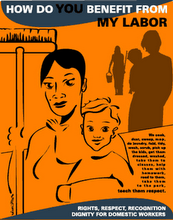Sandra M. Kenley was returning home from her native Barbados in 2005 when she was swept into the United States’ fastest-growing form of incarceration, immigration detention.
Seven weeks later, Ms. Kenley died in a rural Virginia jail, where she had complained of not receiving medicine for high blood pressure. She was one of 62 immigrants to die in administrative custody since 2004, according to a new tally by Immigration and Customs Enforcement that counted many more deaths than the 20 previously known.
No government body is charged with accounting for deaths in immigration detention, a patchwork of county jails, privately run prisons and federal facilities where more than 27,500 people who are not American citizens are held on any given day while the government decides whether to deport them.
Getting details about those who die in custody is a difficult undertaking left to family members, advocacy groups and lawyers.
But as the immigration detention system balloons to meet demands for stricter enforcement of immigration laws, deaths in custody — and the secrecy and confusion around them — are drawing increased scrutiny from lawmakers and from government investigators.
Spurred by bipartisan reports of abuses in detention, the Senate unanimously passed an amendment to the proposed immigration bill that would establish an office of detention oversight within the Department of Homeland Security. Detention capacity would grow by 20,000 beds, or 73 percent, under the bill, which is expected to be debated again today in the Senate.
Complaints focus on a lack of independent oversight and failures to enforce standards for medical care, suicide prevention and access to legal help.
The inspector general in the Department of Homeland Security recently announced a “special review” of two deaths, including that of a Korean woman at a privately run detention center in Albuquerque. Fellow detainees told a lawyer that the woman, Young Sook Kim, had pleaded for medical care for weeks, but received scant attention until her eyes yellowed and she stopped eating.
Ms. Kim died of pancreatic cancer in federal custody on Sept. 11, 2005, a day after she was taken to a hospital.
Some of the sharpest criticism of the troubled system has come from officials at one of the largest detention centers in the country, York County Prison in Pennsylvania.
“The Department of Homeland Security has made it difficult, if not impossible, to meet the constitutional requirements of providing adequate health care to inmates that have a serious need for that care,” the York County Prison’s warden, Thomas Hogan, wrote in a court affidavit last year.
Officials with the immigration agency say that some deaths are inevitable, and that sufficient outside scrutiny comes from local medical examiners. Detention expanded by more than 32 percent last year, and the average length of stay was cut to 35 days from 89, said Jamie Zuieback, a spokeswoman.
“We spend $98 million annually to provide medical care for people in our custody,” Ms. Zuieback said. “Anybody who violates our national immigration law is going to get the same treatment by I.C.E. regardless of their medical condition.”
She declined to release information about the 62 detention deaths since 2004, including names, dates, locations or causes.
Twenty deaths were reported over the same period in a recent briefing paper for the United Nations’ special rapporteur on the human rights of migrants from a list compiled by civil liberties lawyers from reports by relatives, advocates and the news media.
Detention standards were adopted by the immigration agency in 2000, but are not legally enforceable, unlike rules for the treatment of criminal inmates. The Department of Homeland Security has resisted efforts by the American Bar Association to turns the standards into regulations, saying that rulemaking would reduce the agency’s flexibility.
“The deaths bring forward in the worst way the systemwide problems,” said Sunita Patel, a lawyer for Legal Aid who prepared the United Nations briefing paper.
Some advocates of curbs on immigration say the solution is quicker deportations.
“The taxpayer cannot be expected to underwrite the elaborate detention facilities that some of these organizations want,” said Dan Stein, president of the Federation for American Immigration Reform.
In the case of Ms. Kenley, a legal permanent resident of the United States for more than 30 years, detention interrupted her medical care for high blood pressure, a fibroid tumor and uterine bleeding. An autopsy attributed her death to an enlarged heart from chronic hypertensive disease. But a report by emergency medical services said that she had fallen from a top bunk, and that a cellmate had pounded on the door for 20 minutes before guards responded.
Ms. Kenley’s sister, June Everett, said her questions had gone unanswered.
“How did my sister die?” she asked, as Ms. Kenley’s daughter, Nicole, wept. “It’s a whole set of confusion, so who knows, really? And I would like to know.”
Ms. Kenley had been traveling with her 1-year-old granddaughter when she arrived at Washington Dulles International Airport, records show, and she was ordered to return without the baby to discuss two old misdemeanor drug convictions that had surfaced in an airport database.
She obeyed. A transcript shows she admitted a conviction for drug possession in 1984 and one in 2002 for trying to buy a small amount of cocaine. She described a life derailed by drug addiction after 11 years of working in a newspaper mailroom.
“I turned my life around,” Ms. Kenley told the immigration inspector, pointing to three drug-free years after probation and treatment, completion of a nursing course, and legal custody of the granddaughter, Nakita. She also showed that she was taking blood pressure medication and was scheduled for surgery.
The inspector arrested her, invoking the law: two drug-related convictions made her subject to exclusion from the United States.
“I am barely living,” Ms. Kenley later wrote her sister from Pamunkey Regional Jail, in Hanover, Va., “trying to hold on until you get a lawyer to help me.”
She died at Hampton Roads Regional Jail in Portsmouth, Va.
Her only court appearances were by video monitor, waiting for a volunteer lawyer who never came.
Even detainees with legal counsel sometimes do not survive.
Abdoulai Sall, 50, a Guinea-born taxi cab mechanic in Washington with no criminal record, died in detention last December.
Mr. Sall, whose boss of 17 years had sponsored him for a green card, was at an immigration interview with a lawyer, Paul S. Allen, when he was unexpectedly arrested on an old deportation order — part of a legal tangle left when another lawyer abandoned his case in the 1990s, Mr. Allen said.
The case file shows that Mr. Allen’s office urged medical intervention for Mr. Sall, who had been taking medication for a serious kidney ailment at the time of his arrest. While in detention at the Piedmont Regional Jail in Farmville, Va. he complained that he was not getting his medication and that his symptoms were worsening in a barracks-style unit.
Fellow detainees described Mr. Sall huddling next to the unit dryer for warmth, barely able to walk. “The medical staff told him they don’t have what he needs because immigration don’t pay enough money,” one detainee wrote.
The accusation was denied by Lou Barlow, the jail’s superintendent, who said Mr. Sall had received good care, including a visit to the local emergency room.
“We’ve never done anything unethical, illegal or immoral,” Mr. Barlow said.
Autopsy results are still pending.
Some deaths, like Ms. Kim’s, come to light well after the fact. Ms. Kim, a cook of about 60, was swept up in a raid on a massage parlor and detained for a month at the Regional Correctional Center in Albuquerque, a county prison operated by the Cornell Companies, a publicly traded corporation.
Months after her death, a lawyer in Santa Fe, N.M., Brandt Milstein, learned about the case from other Korean detainees, since deported. Mr. Milstein said that under New Mexico law, the death should have been reviewed by the state’s medical inspector, but officials had not reported it as a death in custody.
About two weeks ago — nearly two years after Ms. Kim died — the inspector general’s office called him, Mr. Milstein said. The investigation is now under way.
http://www.nytimes.com/2007/06/26/us/26detain.html?_r=1&hp=&oref=slogin&pagewanted=print















